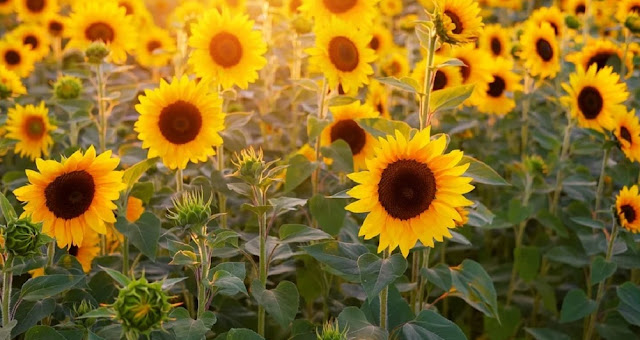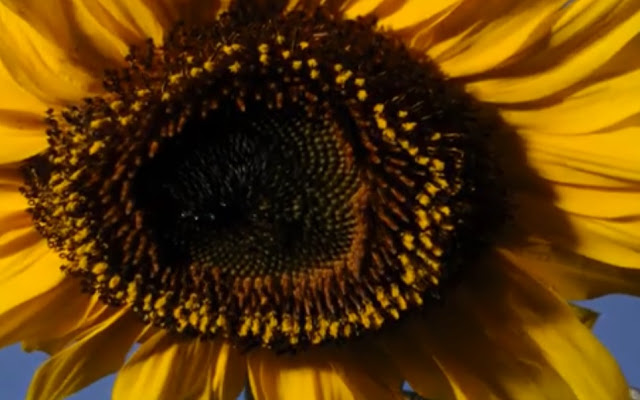Sunflower Cultivation in India; A complete Information Guide
Sunflower Cultivation in India; A complete information Guide ;
The oil of sunflower is light yellow in color and possesses a good odor which can be used for a variety of cooking purposes like any other edible oil. The oil is also used for manufacturing hydrogenated oil.
Origin and History of the sunflower crop ;
Sunflower is a native of the southern United States and Mexico, from where it was introduced into Spain by early explorers and merchants before the middle of the sixteenth century. The sunflower was brought to England from Spain in the Colonial period. In the nineteenth century, the cultivation of sunflower as an oilseed crop began in the Soviet Union, and the majority of the present-day varieties are grown all over the world trace back their origin to the U.S.S.R. Sunflower as an oilseed crop was introduced into India in 1969.
Different type of Sunflowers plants ;
There are about 264 species in the Helianthus genus. All the varieties grown in U.S.S.R. and India are grouped into three main groups.
(1) Large white seeded type: having high oil and content
Climatic Requirements for sunflower Cultivation ;
The crop requires a cool climate during germination and seedling growth. Seedlings tolerate frosts moderately well until they reach the four to the six-leaf stage of development.
Sunflower is a photo-insensitive .crop, therefore, it can be grown successfully in any season viz., Kharif, Rabi, and spring throughout India.
The Soil Requirement for the Cultivation of Sunflower
Sunflower can be grown on a wide range of soils and tolerates a moderate pH range and some salinity.
Recommended Varieties of Sunflower in India ;
|
Variety |
Releasing Centre |
Yield potential (kg/ha) |
Oil content (%) |
Recommended states/regions situations |
Salient features/ traits |
|
DRSF-113 |
DOR, Hyderabad |
1000-1500 |
36-39 |
All India |
High yield |
|
Phule Raviraj |
MPKV, Rahuri |
1795 |
34 |
Western Maharashtra |
Tolerant to Necrosis, Alternaria, and Capitulum borer. |
|
RSFV-901(Kanthi) |
RARS-Raichur |
1200-1400 |
– |
Karnataka |
Tolerant necrosis |
|
Hybrids |
|||||
|
Hybrid |
Releasing Centre |
Yield potential (kg/ha) |
Oil content (%) |
Recommended states/regions situations |
Salient features/ traits |
|
KBSH-53 |
UAS, Bangalore |
1700-2700 |
42-44 |
Karnataka |
Resistant to powdery mildew |
|
PSFH-569 |
PAU Ludhiana |
2232 |
40 |
Punjab |
High oil, early hybrid |
|
Suryamukhi |
PAU, Ludhian |
2000-2200 |
40 |
Punjab |
|
|
DCS-107 |
DOR, Hyd |
1762 |
All India |
Non lodging non shattering |
|
|
RSFH-130 |
RARS, Raichur |
1200-1500 |
40 |
Karnataka |
Tolerant to necrosis |
|
CO-2 |
TNAU, Coimbatore |
1900-2200 |
38-40 |
Tamil Nadu |
Moderate resistant to Alternaria leaf spot, rust & tolerant to thrips and leaf hopper |
|
Olisun 3794 (PAC-3794) |
Advant India ltd |
1594 |
38 |
Maharashtra, TN, Karnataka, AP |
For both rainfed/irrigated & Kharif/rabi, Resistant to downey mildew |
Rotations and Mixed Cropping
Sunflower is grown in rotation with several crops. Some of the important crop rotations are as given below:
1. Maize-sunflower
How to prepare the field for Sunflower Cultivation;
Sunflower requires well pulverized and weed-free land with adequate moisture supply. The first ploughing should be done by the mould-board plough and subsequently, two to three ploughings could be done by local plough followed by planking. Under irrigated conditions where sunflower is to be taken during Rabi, sowing should be done after irrigation.
Sowing of Sunflower Seed ;
Sunflower Seed Treatment;
Sunflower Seed Rate ;
|
Seed Rate |
Verities Kg /ha |
Hybrids Kg/ha |
|
For Rain fed conditions |
7 |
5 |
|
For Irrigated Conditions |
6 |
4 |
Best time of Sunflower Seeds Sowing ;
- If the Kharif crop of sunflower is sown in June, it suffers from lodging. as the heading stage coincides with the heavy rain period of early September
- The Rabi crop sown late in December or January does not make proper germination and growth and heads of smaller size are produced.
- Similarly, Zaid crop sown late in April suffers from heavy rains at harvest time which hampers proper harvesting and threshing of the produce.
After 10-12 days of germination, extra seedlings should be uprooted to provide a space of 20 cms. between plants in rows.
Manures and Fertilisers Requirement for Sunflower Crop;
Sunflower is an exhaustive crop and responds well to nitrogen phosphorus and potash. Therefore, it is necessary to add an adequate amount of manures and fertilizers in the field of sunflower. Nitrogen is essential for vegetative growth but to improve the seed size and its proper filling and to increase oil content liberal supply of phosphorus is essential. Potash also helps in grain filling and disease resistance.
Water Management in Sunflower Crop;
Sunflower is a crop of medium water requirement.
- Usually, no irrigation is needed for the Kharif crop. However, one irrigation should be given in case of uneven distribution of rainfall.
- Pre-sowing irrigation is necessary for Rabi and Zaid crops to get uniform germination and better stand.
- Rabi crop may be irrigated thrice after 40, 75, and 110 days of sowing which will roughly coincide with four to five-leaf stage, flowering, and grain filling stages of the crop.
- Sunflower crop is highly sensitive to water stress between flowering and grain filling stages and at least one of the irrigation must be applied during this period.
- The irrigation requirement of sunflower during the Zaid season is high. It requires four to eight irrigations at an interval of 10-15 days. Irrigation at the grain filling stage should be given light and on a claim and windless evening to avoid lodging.
Weed Control and Earthing in Sunflower Crop ;
Diseases in Sunflower Crop;
There are a number of diseases that are responsible for the reduction in wild both quantitatively and qualitatively. Important diseases and their control measures are being given below:
Seed Rot of sunflower ;
After sowing, some of the seeds rot because of the presence of moulds on their surface. To protect the seed from rot and also to get a good stand in the field, seed should be treated with Captan or Dithane M-45 at the rate of 3 g per kg of seed.
Charcoal Rot of sunflower crop ;
This disease is caused by a fungus, Macrophomina phaseoli. This disease may occur to a considerable extent in the summer crops. The affected plants mature early and when dry show the black ashy color of the stem. Flower heads on the affected plants remain undersized.
Control Measures
(1) Use certified seed only. (2) All infected plants should be removed and burnt. (3) Follow 3-4 years of crop rotation.
Alternaria Blight;
This disease is caused by the fungus, Alternaria helianthi. This disease occurs in severe form during the rainy season. There are dark brown to black round spots on the leaves which later become concentric. There is usually a narrow chlorotic zone around the spots. Under favorable conditions. the spots coalesce and cause blight of leaves. The dead leaves dry up and droop on the stem.
Control Measures
(1) Use certified seeds. (2) Spray weekly 3 kg Dithane M-45 dissolved in 1000 liters of water spray should be given as the disease starts appearing on the lower leaves. A total of four sprays are required.
Sclerotium Wilt ;
Control Measures (1) Collect and burn the affected plants together with 15 cm of surrounding soil. (2) Follow crop rotation. (3) Keep the field free from weeds.
Sclerotinia wilt and Rot ;
This disease is caused by the fungus, Sclerotinia sclerotiorium. This disease mostly appears in the Rabi crops. The wilt symptoms of this are the same as those of Sclerotium wilt except that the sclerotia which are noticed on the affected portion are black, large, and irregular. Sometimes, instead of wilt, rotting of stem and head can be noticed. This can be recognized by shredding of the affected stem and head.
Control Measures
(1) Use certified seeds. (2) Collect and burn the affected plants. (3) Follow-up crop rotation preferably with cereals. (4) Keep the field free from weeds.
Insect Pests of Sunflower Crop;
There are a number of insect pests associated with this crop but only a few sporadic pests cause serious damage to it.
Seedling Pests;
Seedlings are cut at ground level by cutworms usually in patches throughout the field especially if sunflower is sown after potato or in a vegetable area.
Control Measures
Apply 6 liters of Aldrin 30 EC or 10 liters of Heptachlor 20 EC per hectare with irrigation water. Dust of these chemicals can be used in soil before sowing if the area is known for cutworm infestation.
Foliage – Feeding Pests
Various leaf-feeding caterpillars like tobacco caterpillar, Bihar bases caterpillar, Lucerne caterpillar, semi-looper, etc., damage the crop. damage is sporadic and at times very serious. Apart from these call pillars aphids and jassids suck the sap from the leaves and may cause “hopper-burn’.
Control Measures
For the control of various leaf-feeding insects, any one of the insecticides, viz., Folithion or Sumithion 625 milliliter per hectare or Endosulfan 35 EC 1250 milliliter per hectare or Nuvan 100 EC, 500 milliliters per hectare may be used in 1000 liters of water.
Aphids and jassids can be controlled by spraying Metasystox 25 EC or Rogor 30 EC at the rate of 1 liter per hectare or 250-milliliter Dimecron 100 EC in 1000 liters of water.
Ear Head Pests
Apart from the ear head insects like bugs, tobacco caterpillar and gram caterpillars damage the flowers and kernels. A small lyRacid Nysius sp. frequents the flowers and bites the workers around the neck. Parrots and birds eat away the kernels while testa is thrown to the ground.
Control Measures
The crop can be protected for a few days from parrots by dusting 5% malathion dust on both sides of the flower heads when the attack starts. Scaring away the birds is at present the only successful method to avoid losses.
How to control Bird pests Damage Sunflower Crop;
Harvesting and Threshing of sunflower crop;
The sunflower crop is ready for harvest when moisture in the seed is 20 percent. Phenotypically the heads are ripe when the back of the head turns yellowish-brown.
The yield of sunflower Crop;
A good crop of sunflower raised properly and nursed appropriately should yield over 20 quintals per hectare.





